Fougasse Vs Focaccia: What's The Difference In These European Breads?
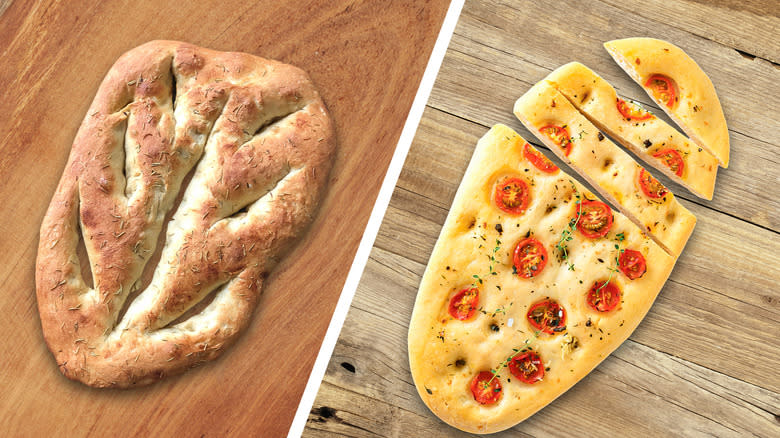
If you've ever eaten at an Italian restaurant, odds are you've seen focaccia on the menu. It's a delicious herb bread packing more flavor than any baked good deserves to have. But what if we told you that focaccia had a French cousin? It's true. It's called fougasse (foo-gaas) and it'll steal you away from your focaccia love affair if you're not careful.
The two breads' shared histories date back to Roman times, to a distant ancestor known as the panis focacius, which translates roughly from Latin to "hearth bread." The ancestral lineage dates back even further, to the pre-Roman Etruscans of North Central Italy and maybe even earlier. However, it was the Romans who brought the concept of hearth bread to France. You can even find a British relative known as hearth cakes and a Spanish pan de hogaza, which were both introduced as the Roman Empire swelled in size. In Roman times, hearth bread was baked right on the ashes and coals of the fireplace and was more commonly eaten by the poor.
Most people aren't cooking their bread on coals these days. But the grandkids of panis focacius are still enjoyed hot and fresh all over the world. The difference between these breads comes down to their shape, their toppings, and how they're prepared.
Read more: 23 Whole Foods Baked Goods, Ranked
What Is Focaccia?
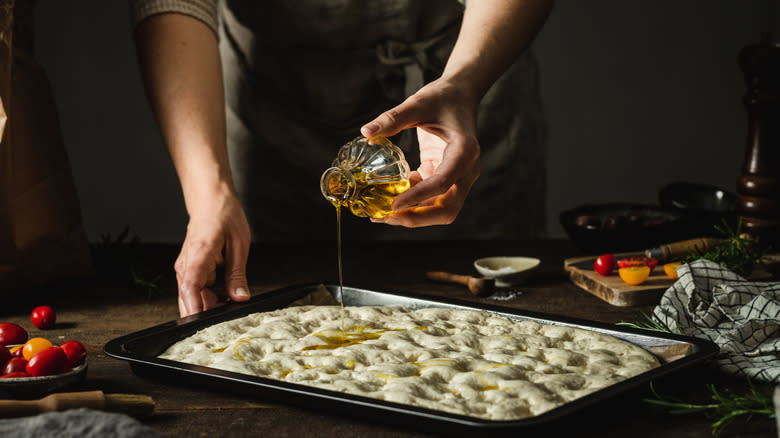
Focaccia is sometimes called Italian flat bread, although it can be a full inch thick at times. It's called that because it's baked in flat sheet pans instead of in a bread loaf pan. They are often rectangular, with a crispy exterior and a fluffy interior. Although focaccia was originally an unleavened bread, meaning it didn't use yeast or any other rising agent, that isn't the case anymore. What's unique about the rising process is that the dough is left to rise while sitting in the sheet pan it bakes in.
The chef will usually make dimples on the top once the dough has risen, providing the characteristic rolling hills for the herbs and olive oil to hang out in. Because of these herbs, focaccia is often considered an herb bread. There are many variations on how to season focaccia. At its most basic, the top is simply covered in sea salt. At the other end, you can have focaccia with chunks of roasted garlic, big pools of olive oil, diced cherry tomatoes, and a generous helping of spices and herbs. It's sometimes served with olive oil or a balsamic vinaigrette dipping sauce, but it's just as good on its own since so much is added to the bread already.
What Is Fougasse?
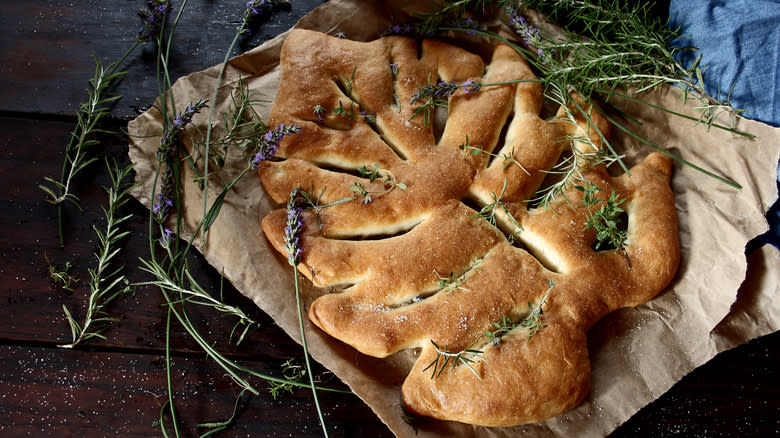
Fougasse is most commonly associated with the Provence region of France, which shares a border with Italy in the southeastern region of the country. It's also considered a flat bread and can be dipped in various tasty things like olive oil or soup. Much like focaccia, fougasse is often treated as an appetizer but it works just as well for a sunny afternoon snack or as a side dish at dinner.
Because they are related to each other, there are more things that the two breads have in common than they have that tell them apart. Fougasse was also cooked over coals in the past and it enjoys a nice herb coating. Legend has it that fougasse was used by French bakers to tell if their oven was hot enough to cook full-sized loaves of bread. If it was, the fougasse would cook and crisp up within a few minutes and the baker got to snack on his tasty test as a bonus.
Focaccia Is Usually Rectangular In Shape
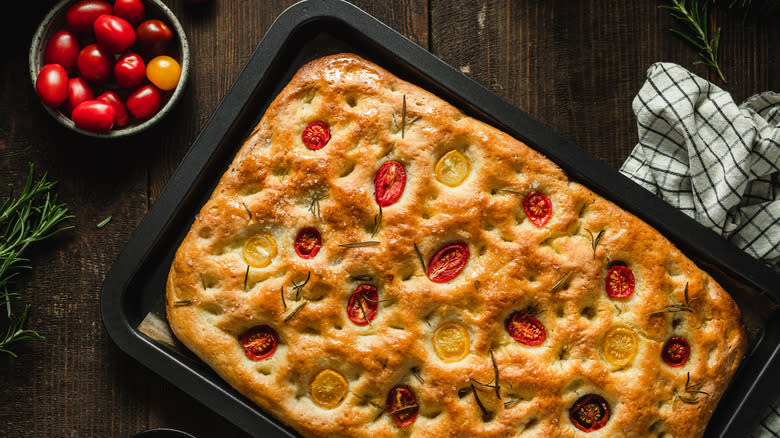
Before you even start to eat, telling these two breads apart is not hard. That's because they look quite different. Focaccia is usually left to rise in rectangular sheet pans before being cooked while fougasse is flattened out by hand into an oval shape.
Secondly, fougasse has slits that are cut down the middle and then off to the side. When it's done baking, this gives the bread the look of a wheat grain or a leaf. The slits are more than just aesthetic, though. By cutting into the bread, you are increasing its surface area, which means the heat of the oven is going to get the fougasse nice and crispy all over.
Although focaccia is crispy on the top and bottom, it is characteristically soft and fluffy on the inside. It comes as a whole, no cuts included, but before it's baked, the cook will press their fingers into the dough to form divots that almost make it look as if it has buttons holding the whole thing together.
The Loaves Are Differentiated By Their Toppings
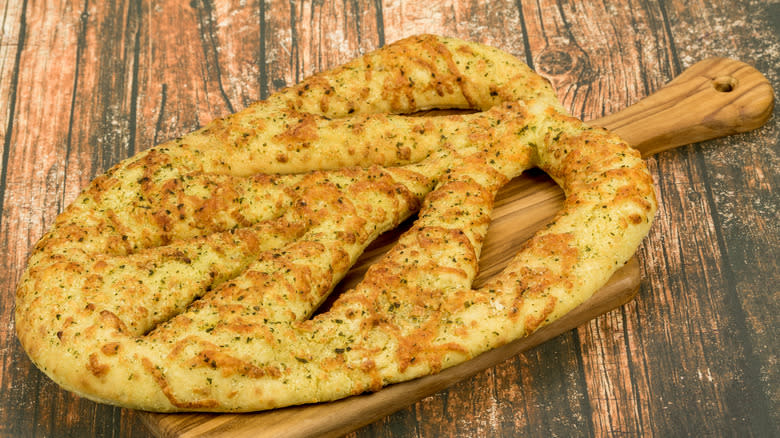
The fact that both focaccia and fougasse have toppings is something that makes them similar and is a sign of their shared ancestral heritage, but the kinds of toppings that are used differentiates them. Each loaf is going to be different since one of the nice things about these breads is that they are highly versatile. You can go as simple as basic salt or you can doll it up with ten different ingredients.
Focaccia leans more towards the herbaceous, with toppings like rosemary, thyme, and basil with olive oil; roasted tomatoes and garlic are added when you're going the extra mile. Fougasse uses herbs de Provence, which includes the same herbs as focaccia but adds fennel, mint, tarragon, and lavender. You can also find fougasse topped with heartier ingredients like anchovies, bacon, and cheese. Modern cooks have taken focaccia and turned it into an impromptu pizza dough, loading it with every ingredient imaginable, but traditionally fougasse would have been the more topping heavy of the two.
Prepping Both Doughs Takes Patience
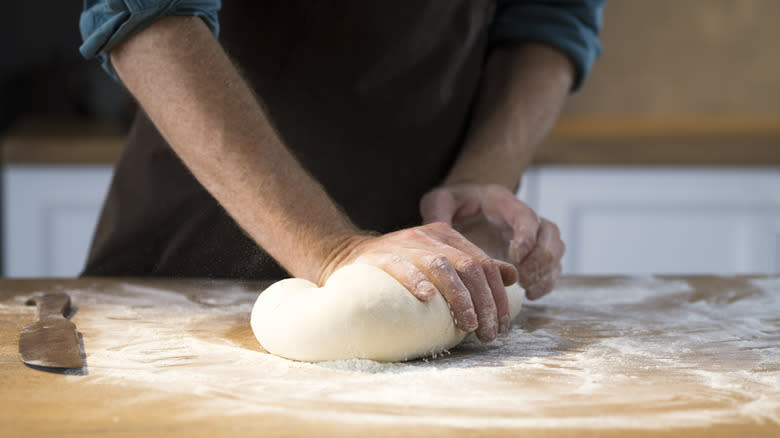
One of the biggest draws about focaccia and fougasse is that they are so much easier to make than regular breads. Good homemade bread can take hours and hours with several labor-intensive steps along the way. Not great for home chefs on a schedule.
Both of these breads can be made from start to finish in a couple of hours, which is a game changer. Some recipes say you should let the dough rest overnight before baking but you don't have to and this can ruin the appeal of these being quick breads to make.
There are a lot of similarities when it comes to making these two doughs; they're both quite minimal, essentially using only flour, water, yeast, and oil. But focaccia is allowed to rise after it has been shaped to the pan it is going to bake in and fougasse is allowed to rise on any flat surface after the slits have been made.
Read the original article on Tasting Table.

